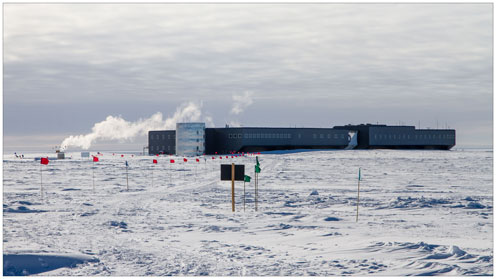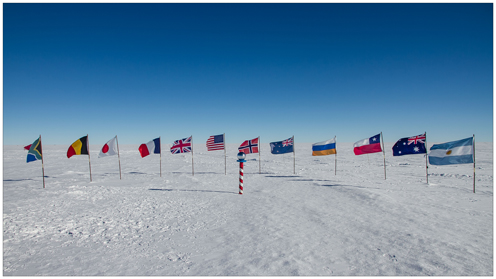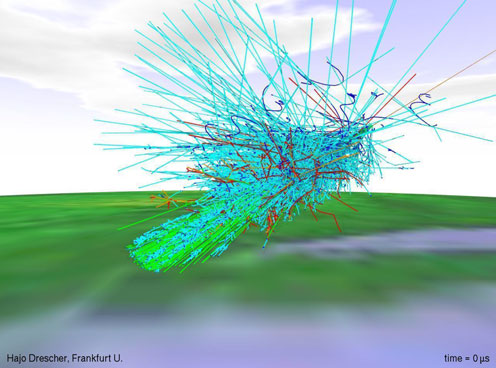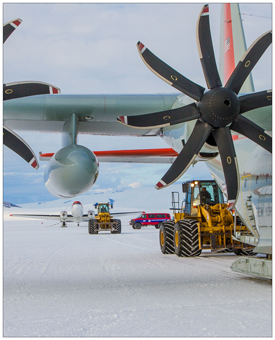From deep under the Antartica-surface: IceCube has collected new knowledge about high-energy neutrino physics
High-energy neutrinos ‘caught’ in Antarctica Scientists from Niels Bohr Institute were part of an international team measuring neutrino interaction at energy levels 1000 times higher than what can be attained in man-made particle generators. The neutrinos performed in accordance with the Standard Model.

Here some of the buildings on IceCube. Underneath the surface, the plant measures one kilometer on each joint - that is, an ice cubes on a cubic mile - and the plant's technical equipment consists of 5,160 ball-shaped optical sensors, which have been lowered into the Arctic ice. Photo: Morten Ankersen Medici
High-energy neutrinos may be halted when they encounter solid matter, e.g. Earth - they don’t ‘just’ go straight through anything.
This is demonstrated by an international research team - 300 scientists from 12 countries - with six team members representing Niels Bohr Institute (NBI) at University of Copenhagen, Denmark. The research also shows - for the first time ever - the probability of this happening.
All neutrinos can interact with matter – they just interact very, very rarely. Additionally, the higher the energy, the more likely a neutrino is to interact with matter.
Neutrino interaction in the form of high-energy neutrinos being halted when encountering solid matter has, however, never previously been measured – and this new result is reported in an article appearing in the current issue of Nature, one of the world’s most prestigious scientific journals.

IceCube, the worlds largest particle detector. ’Installed’ in Antarctica. Illustration: Jason Koskinen.
The research is based on data collected during one year via IceCube - a particle detector ‘installed’ in Antarctica, very close to the South Pole.
The facility spans one kilometer on all sides – a one-cubic-kilometer ice cube – consisting of 5.160 globelike optical sensors each with a diameter of approx. 30 centimeter. The sensors sit deep under the surface of the kilometer thick Antarctica ice – lowered through holes, some of which have been drilled to a depth of 2400 meter.
Neutrinos the most prevalent particles
Neutrinos are the most prevalent particles in the universe. Most of them were made at the beginning of the universe – others result from processes within the sun or from cataclysmic astrophysical occurrences involving e.g. black holes or exploding stars. The neutrino-sample used for the study presented in the current issue of Nature – a total of 10784 – were predominantly atmospheric neutrinos and not from astrophysical sources outside of our planet or galaxy.
Every single second 65 billion neutrinos originating from the sun pass through every single square centimeter of Earth’s surface. These neutrinos, elementary particles practically void of mass, are low-energy neutrinos that will also pass – i.e. go straight through – humans and animals and other living creatures on our planet. And these neutrinos will keep moving in this fashion - in principle for ever – on a journey which will also lead them straight through whatever other planets they might encounter on their route.

Approximately 300 physicists from 49 institutions in 12 countries make up the IceCube Collaboration. The international team is responsible for the scientific program, and many of the collaborators contributed to the design and construction of the detector. Exciting new research conducted by the collaboration is opening a new window for exploring our universe. Photo: Morten Ankersen Medici
But then there´s the ‘other kind of neutrinos’, high-energy neutrinos produced ‘elsewhere’ - in other regions of the universe than where low-energy neutrinos originate from; outside our galaxy and possibly under totally different conditions.
High- and Low-energy Neutrinos
These high-energy neutrinos are the ones researchers all over the world are trying to study via IceCube – which is a challenging undertaking because the high-energy neutrinos are very rare, explains one of the NBI-scientists behind the Nature-article, assistant professor Jason
Koskinen: “In the course of one year IceCube will typically register 10-20 high-energy neutrinos – and when that happens, the 5.000-plus optical sensors deep down in the Antarctica ice will pick up blue flashes of light”.
These flashes are known as Cherenkow radiation – the reaction created when high-energy neutrinos react with the ice – thereby creating new particles, e.g. muons. Until now, however, scientists have not been able to demonstrate that high-energy neutrinos can actually be halted when encountering solid matter.
This reaction has been shown in low energy neutrinos produced in particle accelerators - neutrinos with an energy level of up to approx.
400 gigaelectron volt (GeV) - but never at energy levels beyond.
Proof of this taking place in high energy neutrinos, too, is what the 300 scientists have at long last been able to deliver – which they report in Nature. With the neutrinos measured representing energy levels up to 980 teraelectron volt, TeV, (1 TeV = 1000 GeV).
No new physics
When physicists talk about the Standard Model, they are referring to the current, scientifically based understanding of particle physics. But will the Standard Model hold water in experiments involving particles with a much higher level of energy than the particles hitherto studied in this context?
That is one of the key questions behind the research taking place via IceCube – and the Nature-article does indeed deliver new knowledge in this respect – albeit not quite as spectacular as one might have hoped for, explains another scientist behind the project, Subir Sarkar:

The neutrinos used for this measurement are generated from primary cosmic rays colliding with molecules in the Earth’s atmosphere producing a spray of sub-atomic particles. Amongst the secondary particles created are numerous neutrinos which travel through the Earth, where a only a small fraction interact within the IceCube detector. This process naturally produces higher energy particles than what is possible at man-made facilities, such as the Large Hadron Collider at CERN, which is essential for the recent IceCube cross section measurement. Illustration: Jason Koskinen.
“Had the IceCube-measurements revealed deviations from the Standard Model, the model had – so to speak - not told the full story. Which in turn would have pointed to the existence of unknown physics - ‘New Physics’ - e.g. related to dark matter. But that did not happen”, says Subir Sarkar, NBI-professor at department of Theoretical Particle Physics and Cosmology and head of the Particle Theory Group, Rudolf Peierls Centre for Theoretical Physics, University of Oxford.
When scientists conduct particle experiments they rely on particle accelerators – notably the LHC-facility near Geneva in Switzerland, the largest accelerator of its kind in the world - owned and operated by the European Organization for Particle Physics (CERN).
Modern particle accelerators do, however, have certain limitations – one of these being that they are not able to produce high-energy neutrinos – which forces scientists to look elsewhere for suitable particles if they want to test the reliability of the Standard Model under high-energy conditions.

The IceCube Observatory is located approximately 500 kilometers from the geographic south pole, and all transportation to and from the observatory takes place in the air. Photo: Morten Ankersen Medici
This is where IceCube comes in handily – for the very reason that the Antarctica-based facility is able to register neutrinos representing an energy level about 1000 times higher than found in particles produced via accelerators like LHC.
Physicists focus on high-energy neutrinos for a number of reasons – not least in the hope of being able to deduct information about far-away regions of the universe from where these particles originate. In this context the high-energy neutrinos are seen as some sort of messengers – based on the fact that they can travel cosmic distances without being deflected by magnetic fields and without being halted by the matter they encounter.
In order to actually conduct such studies it is, however, necessary to ‘stop’ some high-energy neutrinos in a particle detector - which is what the 300 scientists behind the new IceCube study managed to accomplish.
The Standard Model holds water
Over the last couple of years a number of physicists have - via theoretically based predictions - dealt with the relationship between the Standard Model and high-energy neutrinos; implicitly hoping that IceCube, the world’s largest particle detector, would sooner or later ‘deliver’ some of these coveted neutrinos.
A large number of these predictions have come to the conclusion that the Standard Model – in all probability – would hold water even when tested against high-energy neutrinos representing an energy level 1.000 times above what can be achieved in LHC and other man-made particle accelerators.
The technical term for this assumption - which has now with a statistical uncertainty of 20 percent and a systematical uncertainty of 40 percent been confirmed - is ‘cross section’, explains Jason Koskinen of NBI:
“Cross section in this context represents the probability of a neutrino interacting with another particle when encountering Earth. The assumptions in support of the Standard Model’s validity even at high-energy levels say that the higher the energy, the higher the possibility of a neutrino hitting another particle – and thereby potentially being halted. And that is exactly what we are able to show in the Nature-article”.

’Cross section’ - reflects the probability of a neutrino interacting with another particle when meeting solid matter, in this case Earth. A number of scientists – professor Subir Sarkar of Niels Bohr Institute being one of them – have argued that the probability of neutrino interaction will be highest in high-energy neutrinos. This was confirmed by the new research carried out via the Antarctica-based IceCube facility. IceCube also allowed the scientists to determine the angle in which the individual high-energy neutrino hit Earth. Illustration: Jason Koskinen
IceCube reveals the in-coming angles of all high-energy neutrinos registered – i.e. the angle in which the individual neutrino hit Earth.
And this made it possible for the scientists to determine how – and how far - the single high-energy neutrino had traveled through Planet Earth before finally being detected by the globelike optical sensors deep down under the surface of the Antarctica ice cap.
This information also carries the possibility of gleaning new knowledge about Earth’s core – which is why the scientific team behind the Nature-article included geologists.
IceCube is efficient and unquestionably offers many interesting possibilities for researchers. Yet wishes for a second generation version of the facility have surfaced within the scientific community – a particle detector ten times larger than the present.
Some scientist even dream of building a facility 100 times larger than IceCube - with a technically different detection system, but still located at the South Pole.
Link to the article:
Photo and video are found here >>
 Subir Sarkar, professor, IceCube, Theoretical Astrophysics and Cosmology, Niels Bohr Institute, University of Copenhagen, Mob: +45 21 28 91 57, Email: sarkar@nbi.ku.dk
Subir Sarkar, professor, IceCube, Theoretical Astrophysics and Cosmology, Niels Bohr Institute, University of Copenhagen, Mob: +45 21 28 91 57, Email: sarkar@nbi.ku.dk
David Jason Koskinen, assistant professori IceCube, Discovery Center, Niels Bohr Institute, University of Copenhagen, Mob: +45 21 28 90 61, Email: koskinen@nbi.ku.dk
Morten Medici, postdoc, IceCube, Discovery Center, Niels Bohr Institute, University of Copenhagen, Tel: +45 3532-5454, Mob: +45 6151-6454, Email: mmedici@nbi.ku.dk
Topics
See also:
Contact
Subir Sarkar, professor, IceCube, Theoretical Astrophysics and Cosmology, Niels Bohr Institute, University of Copenhagen, Mob: +45 21 28 91 57, Email: sarkar@nbi.ku.dk
David Jason Koskinen, assistant professori IceCube, Discovery Center, Niels Bohr Institute, University of Copenhagen, Mob: +45 21 28 90 61, Email: koskinen@nbi.ku.dk
Morten Medici, postdoc, IceCube, Discovery Center, Niels Bohr Institute, University of Copenhagen, Tel: +45 3532-5454, Mob: +45 6151-6454, Email: mmedici@nbi.ku.dk

